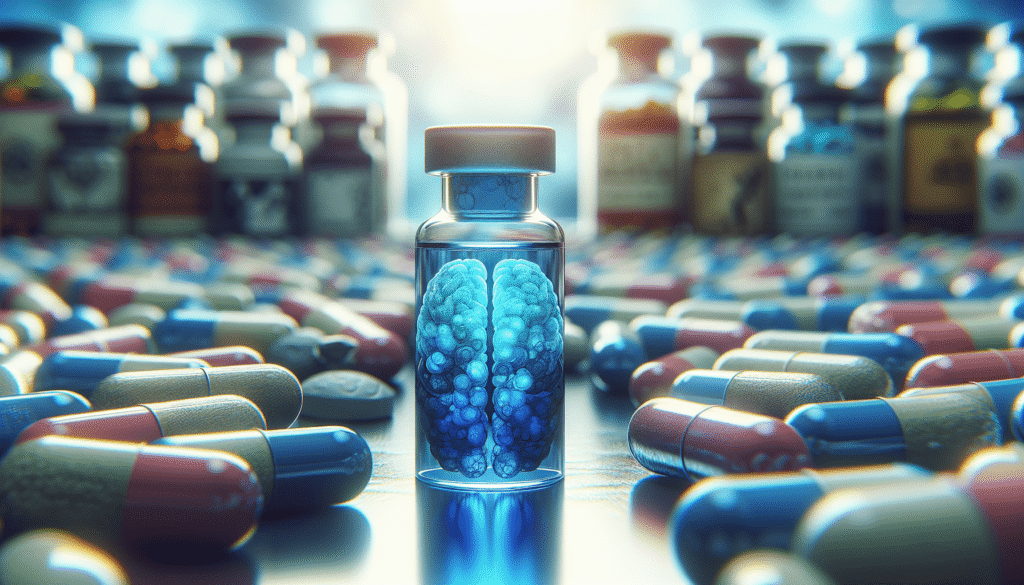
What if there was a way to enhance your cognitive abilities and optimize your mental performance? In recent years, nootropics have gained significant attention for their potential to improve various aspects of brain function, including memory, focus, and creativity. Among these substances, one compound currently stirring the pot is Methylene Blue. Its benefits and efficacy in the realm of nootropics warrant a thorough examination.

Understanding Nootropics
Nootropics, often referred to as “smart drugs,” are substances that purportedly improve cognitive functions in healthy individuals. These enhancements can manifest in various forms, including improved memory retention, heightened alertness, enhanced creativity, and increased motivation. The interest in nootropics spans both the scientific community and the general public, as individuals seek methods to boost their mental capacities in increasingly demanding environments.
The Science Behind Nootropics
The term “nootropic” was coined by Romanian psychologist Corneliu E. Giurgea in the 1970s. He described nootropics as substances that should enhance learning, memory, and overall cognitive function while exhibiting minimal side effects. Nootropics can be classified into several categories, including:
- Natural Nootropics: These are derived from natural sources, such as plants and herbs. Examples include Ginkgo Biloba and Bacopa Monnieri.
- Synthetic Nootropics: These are artificially produced compounds designed to boost cognitive function. Examples include Piracetam and Modafinil.
- Food-based Nootropics: Specific nutrients and substances found in food can also serve as cognitive enhancers, such as caffeine and omega-3 fatty acids.
Understanding the differences between these categories can help you make informed decisions when exploring nootropic options.
Methylene Blue: An Overview
Methylene Blue is a synthetic dye that has been utilized for various medical and industrial purposes since the late 19th century. Recently, Methylene Blue has garnered interest as a nootropic due to its potential neuroprotective properties and its ability to enhance cognitive function.
Origins and Historical Uses
Originally developed as a dye for textiles, Methylene Blue has a long history in medicine as well. It has been used to treat conditions such as malaria, methemoglobinemia, and urinary tract infections. Its ability to improve mitochondrial function and promote oxygen transport within cells is crucial to its medical applications.
While its historical context is certainly impressive, the emerging research surrounding Methylene Blue’s cognitive benefits positions it as a noteworthy contender in the nootropic landscape.
Mechanism of Action
The way Methylene Blue operates within the brain is essential for understanding its potential cognitive-enhancing effects. Here are a few of the mechanisms thought to contribute to its nootropic properties:
-
Mitochondrial Enhancement: Methylene Blue has been shown to improve mitochondrial function, which plays a vital role in energy production. Enhanced energy availability in brain cells can translate to improved cognitive performance.
-
Neuroprotective Effects: Research indicates that Methylene Blue may exhibit neuroprotective properties, potentially shielding neurons from oxidative stress and reducing the risk of neurodegenerative diseases.
-
Modulation of Neurotransmitters: Methylene Blue may influence the levels of key neurotransmitters, including serotonin and dopamine, which are crucial for mood regulation, focus, and motivation.
-
Increased Blood Flow: Some studies suggest that Methylene Blue can enhance cerebral blood flow, which may lead to improved cognitive function by ensuring that the brain receives the oxygen and nutrients it needs.
Methylene Blue in Nootropic Context
With a clearer understanding of what Methylene Blue is and how it functions, it’s essential to evaluate its position among other popular nootropics. Below is a comparison of Methylene Blue with a selection of widely recognized nootropics.
| Nootropic | Main Benefits | Mechanism of Action | Side Effects |
|---|---|---|---|
| Methylene Blue | Neuroprotection, improved mitochondrial function | Increases energy production, protects neurons | Mild headache, fatigue |
| Caffeine | Increased alertness, focus | Blocks adenosine receptors | Insomnia, jitters |
| L-Theanine | Relaxation, improved mood | Increases GABA levels | None known |
| Piracetam | Enhanced memory, learning | Modulates neurotransmitters | Mild gastrointestinal discomfort |
| Modafinil | Improved wakefulness, focus | Increases dopamine signaling | Headache, nausea |
How Methylene Blue Compares
Methylene Blue stands out for its unique combination of neuroprotection and mitochondrial enhancement. While many nootropics serve to stimulate the brain in some manner, Methylene Blue could offer a more holistic approach by addressing underlying cognitive health. Its dual functionality positions it favorably in the nootropic conversation, particularly for individuals seeking more than just a quick mental boost.
Current Research on Methylene Blue
The scientific community has taken a keen interest in examining the cognitive effects of Methylene Blue. Though more research is needed, several studies have highlighted promising findings.
Cognitive Performance Studies
In a notable study published in the journal Neuroscience, researchers discovered that low doses of Methylene Blue improved memory performance in subjects. The mechanism underlying these results seems to involve the compound’s ability to enhance mitochondrial function and optimize energy utilization in the brain.
Another recent study explored the effects of Methylene Blue on age-associated cognitive decline. The findings suggested that Methylene Blue administration improved certain cognitive metrics in older adults, demonstrating its potential as a beneficial supplement for maintaining cognitive health in aging populations.
Neuroprotective Properties
Investigations into the neuroprotective qualities of Methylene Blue have revealed its potential to ward off neurodegenerative diseases, such as Alzheimer’s and Parkinson’s. In models of these diseases, Methylene Blue has exhibited the ability to protect neurons from damage, reduce inflammation, and preserve cognitive function.
While these results are promising, ongoing research is essential to confirm the long-term efficacy and safety of Methylene Blue as a neuroprotective agent.

Safety and Side Effects
When considering Methylene Blue as a nootropic, safety is a crucial factor. While the compound appears to have a relatively low side effect profile, it is essential to be aware of potential reactions.
Mild Side Effects
Some individuals may experience mild side effects from Methylene Blue, including:
- Headaches: Particularly with higher doses.
- Fatigue: Some users report a feeling of tiredness, possibly due to increased energy demands on the body.
- Nausea: Especially if taken without food.
Drug Interactions
Methylene Blue can interact with certain medications, particularly:
-
Serotonin Reuptake Inhibitors (SSRIs): Combining Methylene Blue with SSRIs can increase the risk of serotonin syndrome, a potentially life-threatening condition.
-
Monoamine Oxidase Inhibitors (MAOIs): Similar to the above, the combination can lead to dangerous increases in serotonin levels.
Before starting any new supplement, including Methylene Blue, consult with a healthcare professional to discuss any potential risks, especially if you are currently taking medication.
Dosage Recommendations
Determining the right dosage of Methylene Blue is essential for maximizing its cognitive benefits while minimizing side effects. Current research suggests that effective dosages tend to range from 10 to 50 mg; however, individual tolerances can vary considerably.
Starting with Low Doses
It is advisable to begin at the lower end of the dosing spectrum to assess your body’s response while monitoring for any adverse effects. Gradually increasing the dosage can help you identify the level that works best for your cognitive enhancement goals.
Timing is Key
The timing of Methylene Blue intake can also influence its effectiveness. Taking it in the morning or prior to mentally demanding tasks may yield better results. Remember, consistency is vital for tracking its impact on cognitive performance.
Ways to Incorporate Methylene Blue
Integrating Methylene Blue into your routine can be straightforward. Here are a few tips on how to do so effectively:
-
Supplement Form: Methylene Blue is often available in liquid form, which can be easily dosed. Alternatively, it can be found in capsule form, providing a convenient option for on-the-go use.
-
Mindful Consumption: When incorporating Methylene Blue, be mindful of how it affects your energy levels and cognitive performance. Keeping a journal can help track your response over time.
-
Stacking with Other Nootropics: Some users find that Methylene Blue can be effectively “stacked” with other nootropics, such as L-Theanine or Alpha-GPC, to enhance effectiveness. However, proceed with caution and consult a healthcare professional.
The Future of Nootropics
As interest in cognitive enhancement continues to escalate, the landscape of nootropics is poised for growth and evolution. With emerging research shedding light on the mechanisms and benefits of various compounds, individuals will increasingly explore customized solutions for mental optimization.
Methylene Blue’s Role
As a compound that potentially serves both neuroprotective and cognitive-enhancement roles, Methylene Blue may carve out a unique niche within this expanding market. Its historical medical uses, combined with promising emerging research, positions it as a versatile supplement in the field of cognitive enhancement.
Emphasis on Individualized Approach
As the field develops, it is crucial to recognize that the efficacy of nootropics can vary significantly from person to person. Your optimal cognitive enhancement strategy may involve trial and error, combining elements of various nootropics tailored to your specific needs and circumstances.
Conclusion
Navigating the vast landscape of nootropics, you might find Methylene Blue to be a compelling option, particularly for its dual functionality as both a cognitive enhancer and neuroprotective agent. While research continues to unfold, acknowledging your own body’s responses and working closely with a healthcare professional can help you make informed decisions about incorporating Methylene Blue into your life.
The pursuit of cognitive enhancement through nootropics, including Methylene Blue, invites a careful and informed approach. As more studies emerge and our understanding deepens, you have the potential to harness these advancements to support your mental health and cognitive capabilities. Such proactive engagement will enable you to face the challenges of today’s demanding environments with competence and confidence.